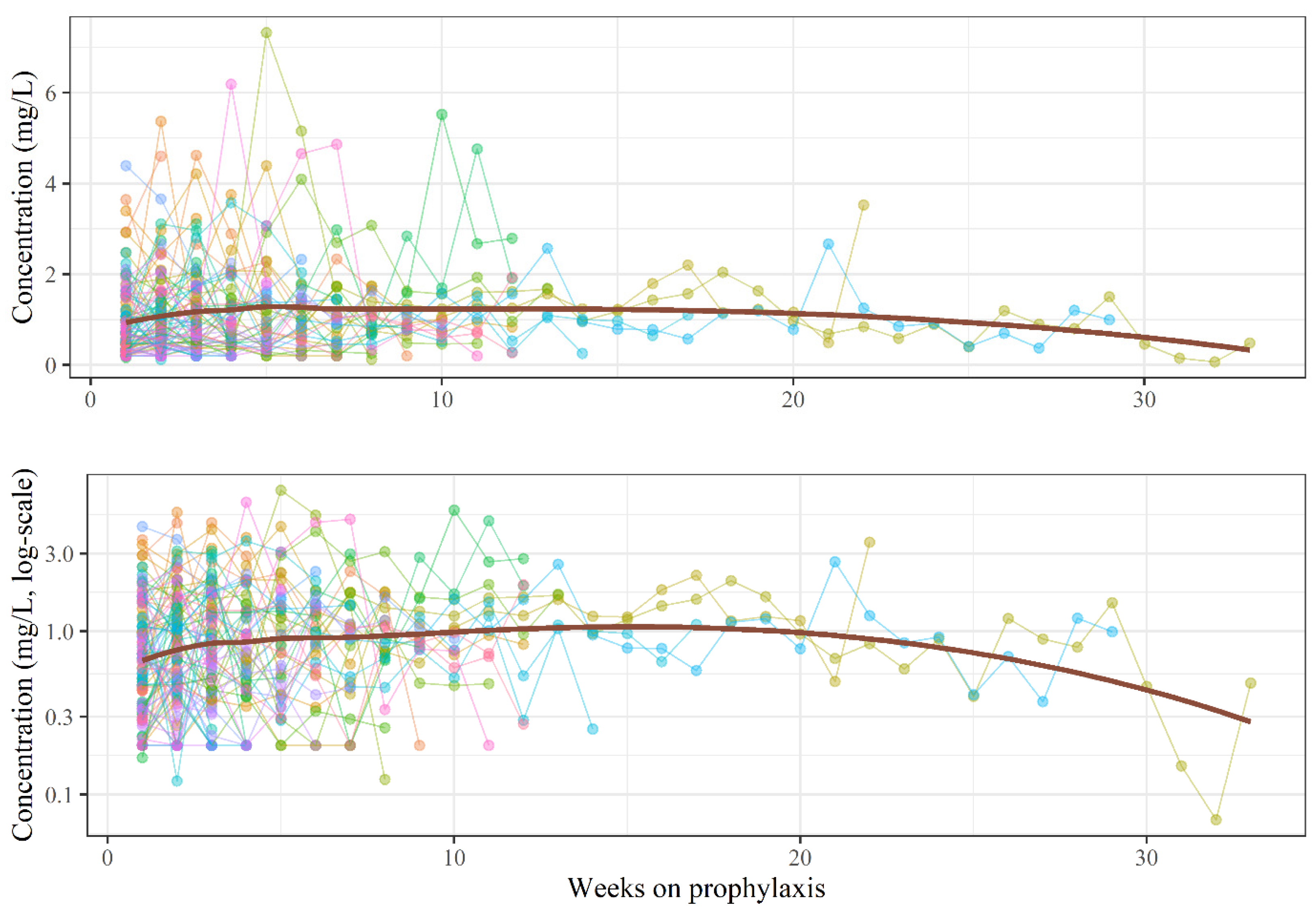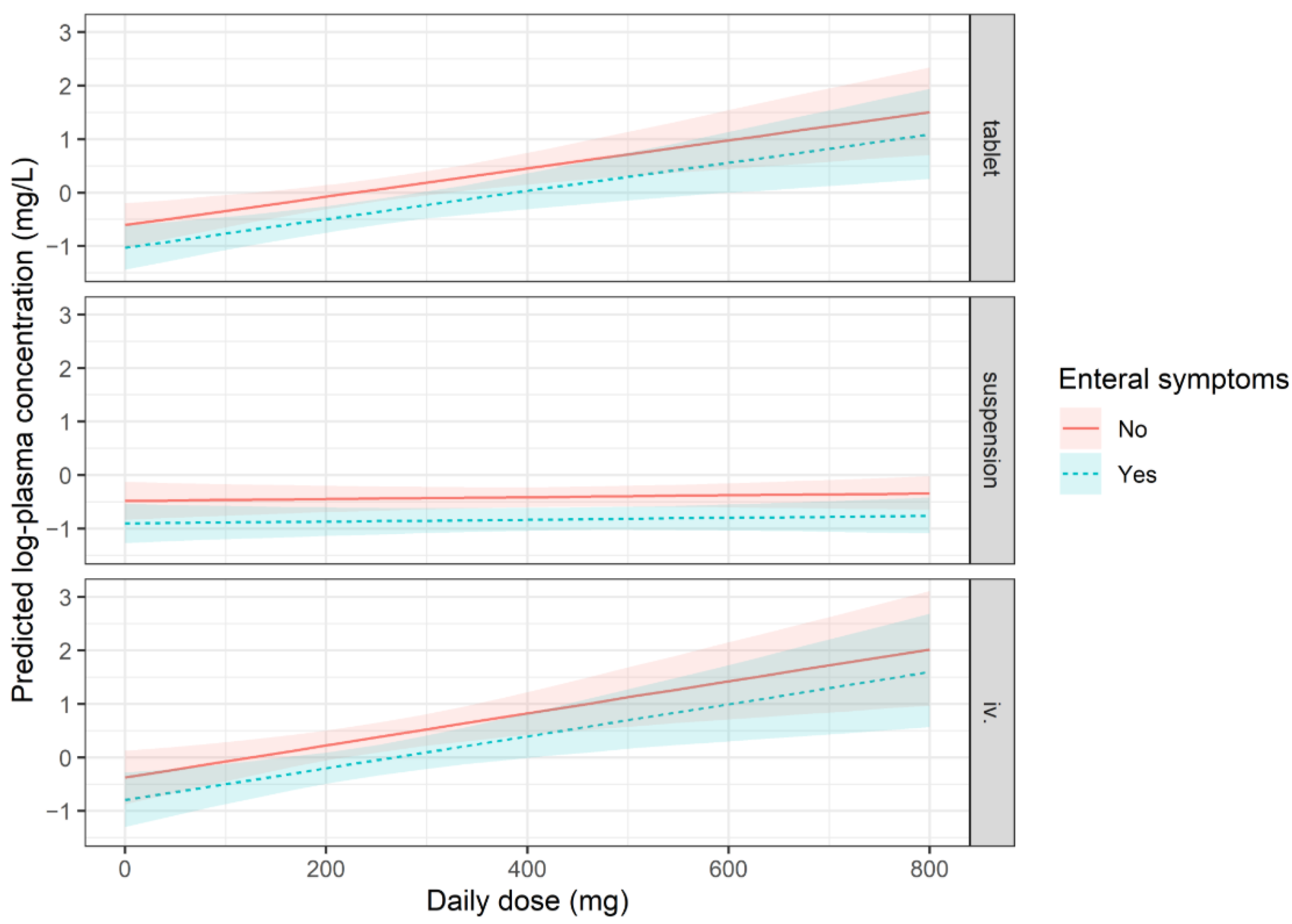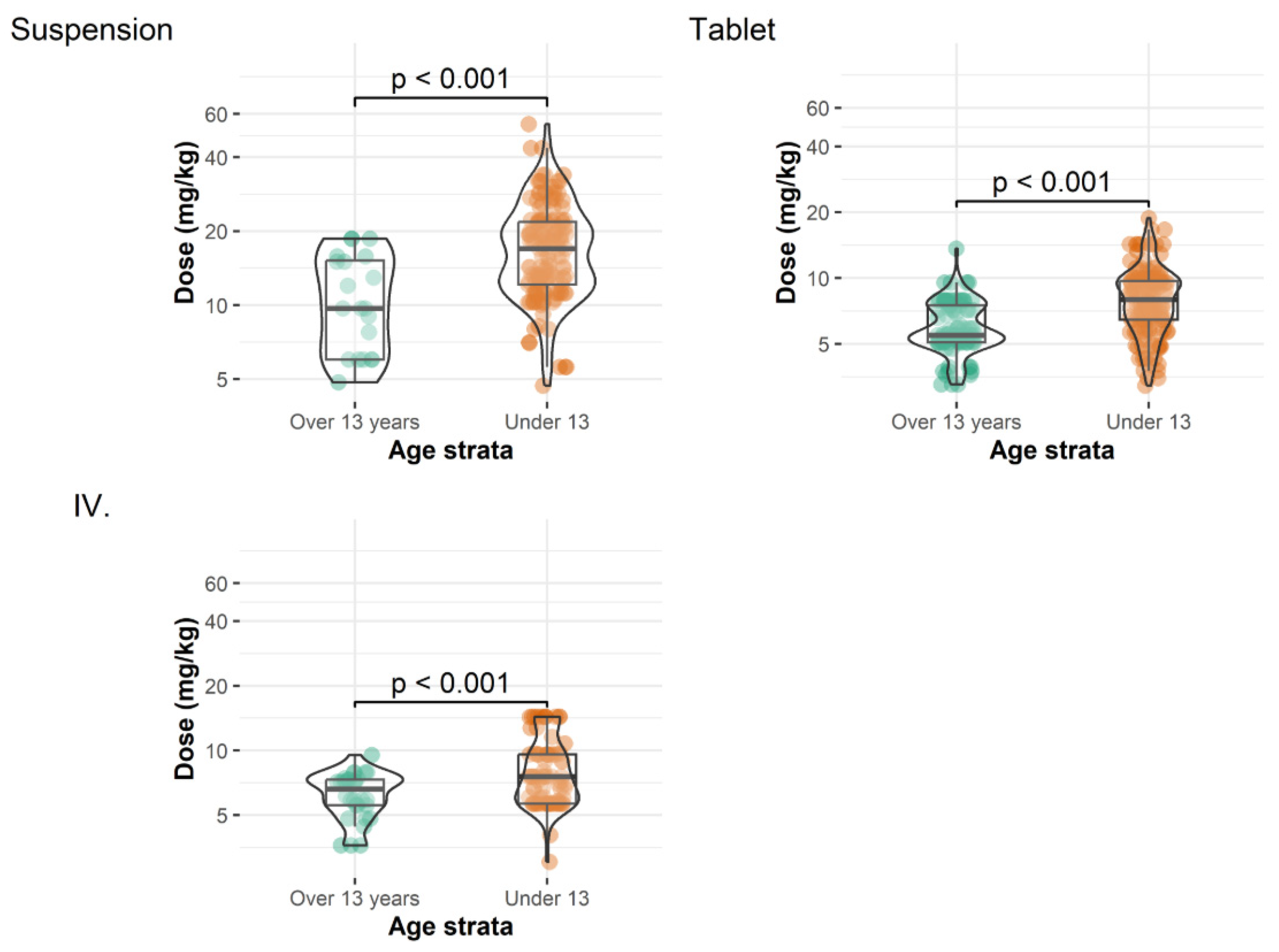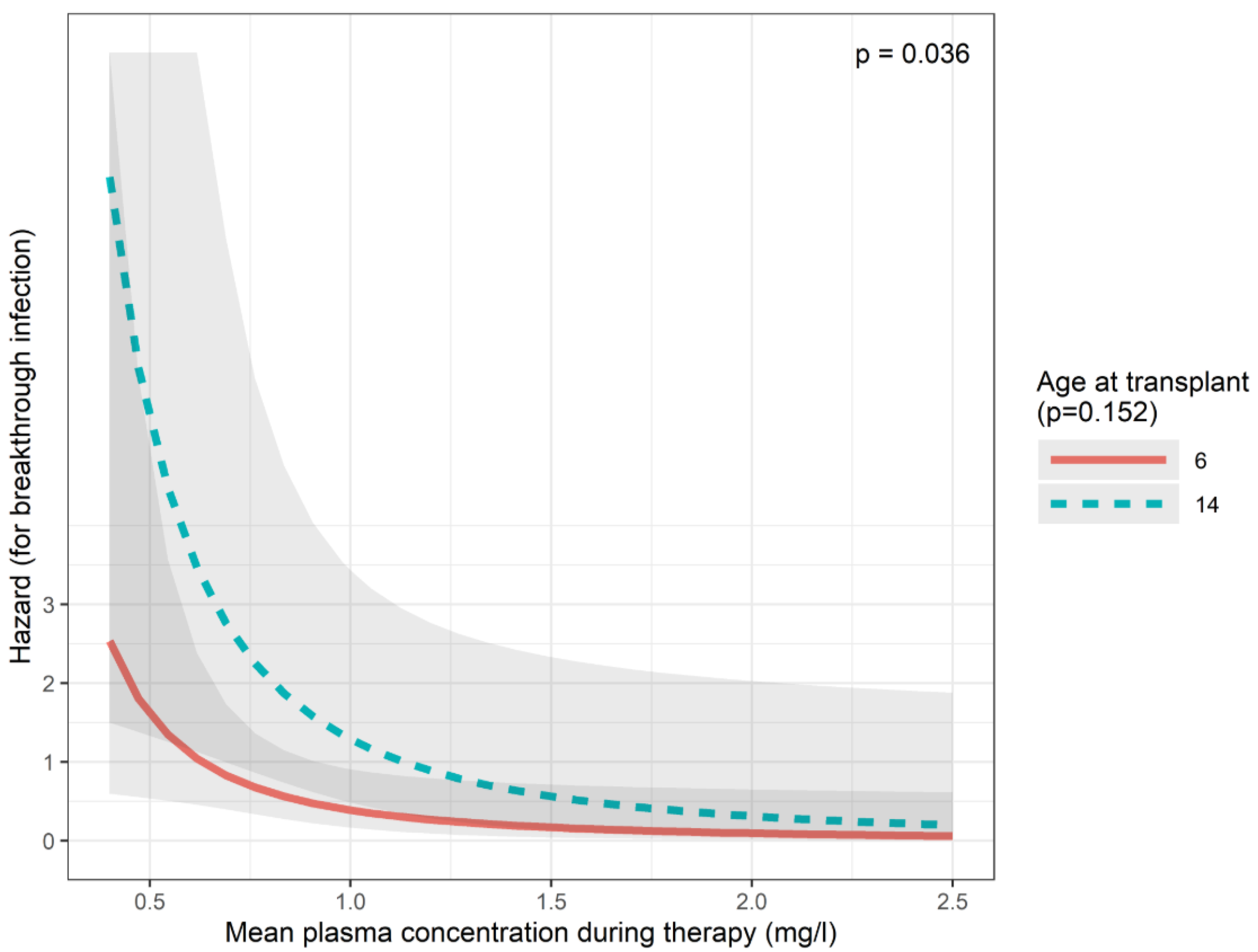Real World Posaconazole Pharmacokinetic Data in Paediatric Stem Cell Transplant Recipients
Abstract
1. Introduction
2. Materials and Methods
2.1. Setting
2.2. Objectives
2.3. Posaconazole Administration and Therapeutical Drug Level Monitoring
2.4. Evaluation of Cmin
- β represents the coefficients,
- i is the subject number,
- j is the week number,
- k is the formulation,
- δ the random effects, and
- ϵ is the residual error.
2.5. Statistical Analysis
3. Results
3.1. Patient Characteristics
3.2. Posaconazole Pharmacokinetics
3.3. Breakthrough Infections and Mortality
3.4. Safety
4. Discussion
5. Conclusions
Supplementary Materials
Author Contributions
Funding
Institutional Review Board Statement
Informed Consent Statement
Data Availability Statement
Acknowledgments
Conflicts of Interest
Appendix A



| Plasma Concentration | 0.7 mg/L | 1.2 mg/L | 1.5 mg/L | 2 mg/L |
|---|---|---|---|---|
| 0.7 mg/L | HR: 1 (1–1) | HR: 0.33 (0.12–0.93) | HR: 0.21 (0.05–0.9) | HR: 0.12 (0.02–0.87) |
| 1.2 mg/L | HR: 3.02 (8.45–1.08) | HR: 1 (1–1) | HR: 0.63 (0.41–0.97) | HR: 0.35 (0.13–0.93) |
| 1.5 mg/L | HR: 4.76 (20.45–1.11) | HR: 1.58 (2.42–1.03) | HR: 1 (1–1) | HR: 0.55 (0.32–0.96) |
| 2 mg/L | HR: 8.59 (63.89–1.15) | HR: 2.85 (7.56–1.07) | HR: 1.8 (3.12–1.04) | HR: 1 (1–1) |
| Plasma Concentration | 0.7 mg/L | 1.2 mg/L | 1.5 mg/L | 2 mg/L |
|---|---|---|---|---|
| 0.7 mg/L | HR: 1 (1–1) | HR: 0.61 (0.34–1.09) | HR: 0.5 (0.22–1.13) | HR: 0.38 (0.12–1.18) |
| 1.2 mg/L | HR: 1.64 (2.93–0.92) | HR: 1 (1–1) | HR: 0.81 (0.64–1.04) | HR: 0.63 (0.36–1.09) |
| 1.5 mg/L | HR: 2.01 (4.58–0.88) | HR: 1.23 (1.56–0.96) | HR: 1 (1–1) | HR: 0.77 (0.56–1.05) |
| 2 mg/L | HR: 2.62 (8.13–0.84) | HR: 1.6 (2.77–0.92) | HR: 1.3 (1.78–0.95) | HR: 1 (1–1) |
References
- Fisher, B.T.; Robinson, P.D.; Lehrnbecher, T.; Steinbach, W.J.; Zaoutis, T.E.; Phillips, B.; Sung, L. Risk Factors for Invasive Fungal Disease in Pediatric Cancer and Hematopoietic Stem Cell Transplantation: A Systematic Review. J. Pediatric Infect. Dis. Soc. 2018, 7, 191–198. [Google Scholar] [CrossRef] [PubMed]
- Dvorak, C.C.; Steinbach, W.J.; Brown, J.M.; Agarwal, R. Risks and outcomes of invasive fungal infections in pediatric patients undergoing allogeneic hematopoietic cell transplantation. Bone Marrow Transplant. 2005, 36, 621–629. [Google Scholar] [CrossRef] [PubMed][Green Version]
- Srinivasan, A.; Wang, C.; Srivastava, D.K.; Burnette, K.; Shenep, J.L.; Leung, W.; Hayden, R.T. Timeline, epidemiology, and risk factors for bacterial, fungal, and viral infections in children and adolescents after allogeneic hematopoietic stem cell transplantation. Biol. Blood Marrow Transplant. 2013, 19, 94–101. [Google Scholar] [CrossRef] [PubMed]
- Hol, J.A.; Wolfs, T.F.; Bierings, M.B.; Lindemans, C.A.; Versluys, A.B.; de Wildt, A.; Gerhardt, C.E.; Boelens, J.J. Predictors of invasive fungal infection in pediatric allogeneic hematopoietic SCT recipients. Bone Marrow Transplant. 2014, 49, 95–101. [Google Scholar] [CrossRef]
- Krishna, G.; Moton, A.; Ma, L.; Medlock, M.M.; McLeod, J. Pharmacokinetics and absorption of posaconazole oral suspension under various gastric conditions in healthy volunteers. Antimicrob. Agents Chemother. 2009, 53, 958–966. [Google Scholar] [CrossRef]
- Boonsathorn, S.; Cheng, I.; Kloprogge, F.; Alonso, C.; Lee, C.; Doncheva, B.; Booth, J.; Chiesa, R.; Irwin, A.; Standing, J.F. Clinical Pharmacokinetics and Dose Recommendations for Posaconazole in Infants and Children. Clin. Pharmacokinet. 2019, 58, 53–61. [Google Scholar] [CrossRef]
- Mauro, M.; Colombini, A.; Perruccio, K.; Zama, D.; D’Amico, M.R.; Calore, E.; Carraro, F.; Muggeo, P.; Tridello, G.; Baretta, V.; et al. Posaconazole delayed-release tablets in paediatric haematology-oncology patients. Mycoses 2020, 63, 604–609. [Google Scholar] [CrossRef]
- Lambrix, A.A.; Swanson, H.D.; Pauley, J.L.; Bragg, A.W.; Carias, D.C.; Bourque, M.S.; Zhou, Y.; Cheng, C.; Greene, W.L.; Maron, G. Experience using intravenous posaconazole in paediatric and young adult oncology patients. J. Antimicrob. Chemother. 2020, 75, 3682–3687. [Google Scholar] [CrossRef]
- Groll, A.H.; Abdel-Azim, H.; Lehrnbecher, T.; Steinbach, W.J.; Paschke, A.; Mangin, E.; Winchell, G.A.; Waskin, H.; Bruno, C.J. Pharmacokinetics and safety of posaconazole intravenous solution and powder for oral suspension in children with neutropenia: An open-label, sequential dose-escalation trial. Int. J. Antimicrob. Agents 2020, 56, 106084. [Google Scholar] [CrossRef]
- Patterson, T.F.; Thompson, G.R.; Denning, D.W.; Fishman, J.A.; Hadley, S.; Herbrecht, R.; Kontoyiannis, D.P.; Marr, K.A.; Morrison, V.A.; Nguyen, M.H.; et al. Practice Guidelines for the Diagnosis and Management of Aspergillosis: 2016 Update by the Infectious Diseases Society of America. Clin. Infect. Dis. 2016, 63, e1–e60. [Google Scholar] [CrossRef]
- Ullmann, A.J.; Aguado, J.M.; Arikan-Akdagli, S.; Denning, D.W.; Groll, A.H.; Lagrou, K.; Lass-Flörl, C.; Lewis, R.E.; Munoz, P.; Verweij, P.E.; et al. Diagnosis and management of Aspergillus diseases: Executive summary of the 2017 ESCMID-ECMM-ERS guideline. Clin. Microbiol. Infect. 2018, 24 (Suppl. S1), e1–e38. [Google Scholar] [CrossRef] [PubMed]
- Groll, A.H.; Pana, D.; Lanternier, F.; Mesini, A.; Ammann, R.A.; Averbuch, D.; Castagnola, E.; Cesaro, S.; Engelhard, D.; Garcia-Vidal, C.; et al. 8th European Conference on Infections in Leukaemia: 2020 guidelines for the diagnosis, prevention, and treatment of invasive fungal diseases in paediatric patients with cancer or post-haematopoietic cell transplantation. Lancet Oncol. 2021, 22, e254–e269. [Google Scholar] [CrossRef] [PubMed]
- Walsh, T.J.; Raad, I.; Patterson, T.F.; Chandrasekar, P.; Donowitz, G.R.; Graybill, R.; Greene, R.E.; Hachem, R.; Hadley, S.; Herbrecht, R.; et al. Treatment of invasive aspergillosis with posaconazole in patients who are refractory to or intolerant of conventional therapy: An externally controlled trial. Clin. Infect. Dis. 2007, 44, 2–12. [Google Scholar] [CrossRef] [PubMed]
- Dolton, M.J.; Ray, J.E.; Marriott, D.; McLachlan, A.J. Posaconazole exposure-response relationship: Evaluating the utility of therapeutic drug monitoring. Antimicrob. Agents Chemother. 2012, 56, 2806–2813. [Google Scholar] [CrossRef]
- Chen, L.; Wang, Y.; Zhang, T.; Li, Y.; Meng, T.; Liu, L.; Hao, R.; Dong, Y. Utility of posaconazole therapeutic drug monitoring and assessment of plasma concentration threshold for effective prophylaxis of invasive fungal infections: A meta-analysis with trial sequential analysis. BMC Infect. Dis. 2018, 18, 155. [Google Scholar] [CrossRef]
- Aigner, M.; Lass-Flörl, C. Treatment of drug-resistant Aspergillus infection. Expert. Opin. Pharmacother. 2015, 16, 2267–2270. [Google Scholar] [CrossRef]
- Peña-Lorenzo, D.; Rebollo, N.; Sánchez-Hernández, J.G.; Zarzuelo-Castañeda, A.; Vázquez-López, L.; Otero, M.J.; Pérez-Blanco, J.S. Population pharmacokinetics of a posaconazole tablet formulation in transplant adult allogeneic stem cell recipients. Eur. J. Pharm. Sci. 2022, 168, 106049. [Google Scholar] [CrossRef]
- Bates, D.; Mächler, M.; Bolker, B.; Walker, S. Fitting Linear Mixed-Effects Models Using lme4. J. Stat. Softw. 2015, 67, 1–48. [Google Scholar] [CrossRef]
- De Pauw, B.; Walsh, T.J.; Donnelly, J.P.; Stevens, D.A.; Edwards, J.E.; Calandra, T.; Pappas, P.G.; Maertens, J.; Lortholary, O.; Kauffman, C.A.; et al. Revised definitions of invasive fungal disease from the European Organization for Research and Treatment of Cancer/Invasive Fungal Infections Cooperative Group and the National Institute of Allergy and Infectious Diseases Mycoses Study Group (EORTC/MSG) Consensus Group. Clin. Infect. Dis. 2008, 46, 1813–1821. [Google Scholar] [CrossRef]
- Lai, T.; Alffenaar, J.W.; Kesson, A.; Bandodkar, S.; Roberts, J.A. Evaluation of target attainment of oral posaconazole suspension in immunocompromised children. J. Antimicrob. Chemother. 2020, 75, 726–729. [Google Scholar] [CrossRef]
- Jia, M.; Zhang, Q.; Qin, Z.; Wang, D.; Liu, P.; Yang, J.; Zhang, X. Dose Optimisation of Posaconazole and Therapeutic Drug Monitoring in Pediatric Patients. Front. Pharmacol. 2022, 13, 833303. [Google Scholar] [CrossRef]
- Döring, M.; Cabanillas Stanchi, K.M.; Klinker, H.; Eikemeier, M.; Feucht, J.; Blaeschke, F.; Schwarze, C.P.; Ebinger, M.; Feuchtinger, T.; Handgretinger, R.; et al. Posaconazole plasma concentrations in pediatric patients receiving antifungal prophylaxis during neutropenia. Med. Mycol. 2017, 55, 375–384. [Google Scholar] [CrossRef] [PubMed]
- Garner, L.M.; Ngo, S.; Kaplan, J.B.; Wilson, W.S.; McKinzie, C.J. Evaluation of Posaconazole Dosing in Children and Young Adults: A Single-Center Review. J. Pediatr. Pharmacol. Ther. 2021, 26, 834–840. [Google Scholar] [CrossRef] [PubMed]
- Gross, B.N.; Ihorst, G.; Jung, M.; Wäsch, R.; Engelhardt, M. Posaconazole therapeutic drug monitoring in the real-life setting: A single-center experience and review of the literature. Pharmacotherapy 2013, 33, 1117–1125. [Google Scholar] [CrossRef]
- Kraft, W.K.; Chang, P.S.; van Iersel, M.L.; Waskin, H.; Krishna, G.; Kersemaekers, W.M. Posaconazole tablet pharmacokinetics: Lack of effect of concomitant medications altering gastric pH and gastric motility in healthy subjects. Antimicrob. Agents Chemother. 2014, 58, 4020–4025. [Google Scholar] [CrossRef]
- Haegler, P.; Joerin, L.; Krähenbühl, S.; Bouitbir, J. Hepatocellular Toxicity of Imidazole and Triazole Antimycotic Agents. Toxicol. Sci. 2017, 157, 183–195. [Google Scholar] [CrossRef]
- Bühler, T.; Medinger, M.; Bouitbir, J.; Krähenbühl, S.; Leuppi-Taegtmeyer, A. Hepatotoxicity Due to Azole Antimycotic Agents in a HLA B*35:02-Positive Patient. Front. Pharmacol. 2019, 10, 645. [Google Scholar] [CrossRef]
- Cornely, O.A.; Duarte, R.F.; Haider, S.; Chandrasekar, P.; Helfgott, D.; Jiménez, J.L.; Candoni, A.; Raad, I.; Laverdiere, M.; Langston, A.; et al. Phase 3 pharmacokinetics and safety study of a posaconazole tablet formulation in patients at risk for invasive fungal disease. J. Antimicrob. Chemother. 2016, 71, 1747. [Google Scholar] [CrossRef]
- Kuriakose, K.; Nesbitt, W.J.; Greene, M.; Harris, B. Posaconazole-Induced Pseudohyperaldosteronism. Antimicrob. Agents Chemother. 2018, 62, 02130-17. [Google Scholar] [CrossRef]
- Thompson, G.R.; Chang, D.; Wittenberg, R.R.; McHardy, I.; Semrad, A. 11β-Hydroxysteroid Dehydrogenase Inhibition in Posaconazole-Induced Hypertension and Hypokalemia. Antimicrob. Agents Chemother. 2017, 61, 00760-17. [Google Scholar] [CrossRef]
- Thompson, G.R.; Beck, K.R.; Patt, M.; Kratschmar, D.V.; Odermatt, A. Posaconazole-Induced Hypertension Due to Inhibition of 11. J. Endocr. Soc. 2019, 3, 1361–1366. [Google Scholar] [CrossRef] [PubMed]
- Barton, K.; Davis, T.K.; Marshall, B.; Elward, A.; White, N.H. Posaconazole-Induced hypertension and hypokalemia due to inhibition of the 11β-hydroxylase enzyme. Clin. Kidney J. 2018, 11, 691–693. [Google Scholar] [CrossRef] [PubMed]
- Agarwal, N.; Apperley, L.; Taylor, N.F.; Taylor, D.R.; Ghataore, L.; Rumsby, E.; Treslove, C.; Holt, R.; Thursfield, R.; Senniappan, S. Posaconazole-Induced Hypertension Masquerading as Congenital Adrenal Hyperplasia in a Child with Cystic Fibrosis. Case Rep. Med. 2020, 2020, 8153012. [Google Scholar] [CrossRef] [PubMed]
- Nguyen, M.H.; Davis, M.R.; Wittenberg, R.; Mchardy, I.; Baddley, J.W.; Young, B.Y.; Odermatt, A.; Thompson, G.R. Posaconazole Serum Drug Levels Associated with Pseudohyperaldosteronism. Clin. Infect. Dis. 2020, 70, 2593–2598. [Google Scholar] [CrossRef]
- Lerolle, N.; Raffoux, E.; Socie, G.; Touratier, S.; Sauvageon, H.; Porcher, R.; Bretagne, S.; Bergeron, A.; Azoulay, E.; Molina, J.M.; et al. Breakthrough invasive fungal disease in patients receiving posaconazole primary prophylaxis: A 4-year study. Clin. Microbiol. Infect. 2014, 20, O952–O959. [Google Scholar] [CrossRef]
- Lenczuk, D.; Zinke-Cerwenka, W.; Greinix, H.; Wölfler, A.; Prattes, J.; Zollner-Schwetz, I.; Valentin, T.; Lin, T.C.; Meinitzer, A.; Hoenigl, M.; et al. Antifungal Prophylaxis with Posaconazole Delayed-Release Tablet and Oral Suspension in a Real-Life Setting: Plasma Levels, Efficacy, and Tolerability. Antimicrob. Agents Chemother. 2018, 62, 02655-17. [Google Scholar] [CrossRef]
- Li, W.; Xia, F.; Zhou, H.; Qiu, H.; Wu, D.; Ma, X.; Sun, A. Efficacy of Posaconazole Prophylaxis for Fungal Disease in Hematology Patients Treated with Chemotherapy and Transplantation: An Open-Label, Prospective, Observational Study. Front. Microbiol. 2020, 11, 349. [Google Scholar] [CrossRef]
- Chen, X.; Wang, J.; Wang, S.; Jin, J.; Li, J.; Gao, S.; Liu, Q.; Hu, Y.; Lin, D.; Sun, Z.; et al. Real-world assessment of the effectiveness of posaconazole for the prophylaxis and treatment of invasive fungal infections in hematological patients: A retrospective observational study. Medicine 2021, 100, e26772. [Google Scholar] [CrossRef]
- Maquera-Afaray, J.; Luna-Vilchez, M.; Salazar-Mesones, B.; Portillo-Alvarez, D.; Uribe-Ramirez, L.; Taipe-Sedano, G.; Santillán-Salas, C.; López, J.W. Antifungal Prophylaxis with Posaconazole in Immunocompromised Children Younger than 13 Years. J. Pediatr. Pharmacol. Ther. 2022, 27, 57–62. [Google Scholar] [CrossRef]
- Eiden, C.; Meniane, J.C.; Peyrière, H.; Eymard-Duvernay, S.; Le Falher, G.; Ceballos, P.; Fegueux, N.; Cociglio, M.; Reynes, J.; Hillaire-Buys, D. Therapeutic drug monitoring of posaconazole in hematology adults under posaconazole prophylaxis: Influence of food intake. Eur. J. Clin. Microbiol. Infect. Dis. 2012, 31, 161–167. [Google Scholar] [CrossRef]
- Lebeaux, D.; Lanternier, F.; Elie, C.; Suarez, F.; Buzyn, A.; Viard, J.P.; Bougnoux, M.E.; Lecuit, M.; Jullien, V.; Lortholary, O. Therapeutic drug monitoring of posaconazole: A monocentric study with 54 adults. Antimicrob. Agents Chemother. 2009, 53, 5224–5229. [Google Scholar] [CrossRef] [PubMed]
- Shields, R.K.; Clancy, C.J.; Vadnerkar, A.; Kwak, E.J.; Silveira, F.P.; Massih, R.C.; Pilewski, J.M.; Crespo, M.; Toyoda, Y.; Bhama, J.K.; et al. Posaconazole serum concentrations among cardiothoracic transplant recipients: Factors impacting trough levels and correlation with clinical response to therapy. Antimicrob. Agents Chemother. 2011, 55, 1308–1311. [Google Scholar] [CrossRef] [PubMed][Green Version]
- Kraljevic, M.; Khanna, N.; Medinger, M.; Passweg, J.; Masouridi-Levrat, S.; Chalandon, Y.; Mueller, N.J.; Schanz, U.; Vernaz, N.; Van Delden, C.; et al. Clinical considerations on posaconazole administration and therapeutic drug monitoring in allogeneic hematopoietic cell transplant recipients. Med. Mycol. 2021, 59, 701–711. [Google Scholar] [CrossRef] [PubMed]
- Lamoth, F.; Chung, S.J.; Damonti, L.; Alexander, B.D. Changing Epidemiology of Invasive Mold Infections in Patients Receiving Azole Prophylaxis. Clin. Infect. Dis. 2017, 64, 1619–1621. [Google Scholar] [CrossRef]
- Puerta-Alcalde, P.; Garcia-Vidal, C. Changing Epidemiology of Invasive Fungal Disease in Allogeneic Hematopoietic Stem Cell Transplantation. J. Fungi 2021, 7, 848. [Google Scholar] [CrossRef]



| Characteristic | Overall n = 102 1 | Suspension n = 42 1 | Tablet n = 47 1 | Intravenous n = 13 1 | p-Value 2 |
|---|---|---|---|---|---|
| Age at transplant (years) | 9.4 (5.9, 13.0) | 5.9 (2.7, 10.1) | 11.6 (8.7, 14.2) | 8.5 (5.3, 11.9) | <0.001 |
| Mass (kg) | 30 (21, 43) | 23 (13, 32) | 35 (29, 53) | 25 (17, 53) | <0.001 |
| Sex (female) | 30 (29%) | 9 (21%) | 15 (32%) | 6 (46%) | 0.2 |
| Height (cm) | 134 (111, 156) | 116 (91, 140) | 144 (130, 162) | 122 (110, 168) | <0.001 |
| BSA | 1.04 (0.80, 1.36) | 0.86 (0.55, 1.13) | 1.15 (1.03, 1.60) | 0.91 (0.72, 1.60) | <0.001 |
| Primary disease category | 0.5 | ||||
| ALL | 23 (23%) | 7 (17%) | 12 (26%) | 4 (31%) | |
| AML | 14 (14%) | 6 (14%) | 6 (13%) | 2 (15%) | |
| Other Malignancy | 14 (14%) | 6 (14%) | 5 (11%) | 3 (23%) | |
| MDS | 28 (27%) | 9 (21%) | 17 (36%) | 2 (15%) | |
| Severe aplastic anemia | 8 (7.8%) | 4 (9.5%) | 4 (8.5%) | 0 (0%) | |
| Congenital defect | 14 (14%) | 9 (21%) | 3 (6.4%) | 2 (15%) | |
| Other | 1 (1.0%) | 1 (2.4%) | 0 (0%) | 0 (0%) | |
| Myeloablative conditioning | 69 (68%) | 27 (64%) | 32 (68%) | 10 (77%) | 0.7 |
| Serotherapy | 84 (82%) | 34 (81%) | 37 (79%) | 13 (100%) | 0.2 |
| Donor type | 0.11 | ||||
| Matched family donor | 3 (2.9%) | 1 (2.4%) | 2 (4.3%) | 0 (0%) | |
| Haploidentical donor | 13 (13%) | 2 (4.8%) | 8 (17%) | 3 (23%) | |
| Unrelated donor | 64 (63%) | 28 (67%) | 26 (55%) | 10 (77%) | |
| Matched sibling donor | 22 (22%) | 11 (26%) | 11 (23%) | 0 (0%) | |
| Type of graft | 0.3 | ||||
| Bone marrow | 65 (64%) | 30 (71%) | 29 (62%) | 6 (46%) | |
| Cord blood | 6 (5.9%) | 2 (4.8%) | 2 (4.3%) | 2 (15%) | |
| Peripheral blood | 31 (30%) | 10 (24%) | 16 (34%) | 5 (38%) | |
| Indication | 0.034 | ||||
| Acute GvHD | 13 (13%) | 9 (21%) | 2 (4.3%) | 2 (15%) | |
| Neutropenia and aGvHD | 12 (12%) | 3 (7.1%) | 9 (19%) | 0 (0%) | |
| Neutropenia post HSCT | 70 (69%) | 25 (60%) | 34 (72%) | 11 (85%) | |
| Other | 7 (6.9%) | 5 (12%) | 2 (4.3%) | 0 (0%) |
| Plasma Concentration Category | Suspension n = 166 1 | Tablet n = 255 1 | Intravenous n = 111 1 | p-Value 2 |
|---|---|---|---|---|
| low (<0.7 mg/L) | 18.62 (6.60) | 6.98 (2.76) | 6.85 (1.70) | |
| medium (0.7–2 mg/L) | 15.22 (8.70) | 7.52 (2.62) | 7.84 (2.84) | |
| high (>2 mg/L) | 17.09 (10.18) | 8.27 (2.54) | 9.37 (4.16) | |
| Overall dose | 17.23 (8.12) | 7.41 (2.68) | 7.75 (2.83) | 0.002 |
| Low (<0.7 mg/L) | Medium (0.7–2 mg/L) | High (>2 mg/L) | |||||||
|---|---|---|---|---|---|---|---|---|---|
| Formulation | ≥13 Years (n = 61 1) | <13 Years (n = 144 1) | p-Value 2 | ≥13 Years (n = 80 1) | <13 Years (n = 174 1) | p-Value 2 | ≥13 Years (n = 12 1) | <13 Years (n = 61 1) | p-Value 2 |
| Suspension | 16 (3.2) | 19 (8.9) | 0.2 | 6.0 (3.7) | 13 (8.5) | <0.001 | 9.3 (1.8) | 14 (8.9) | 0.017 |
| Tablet | 5.4 (2.1) | 6.9 (3.7) | <0.001 | 5.9 (2.8) | 7.9 (3.0) | <0.001 | 5.9 (1.4) | 9.7 (2.9) | 0.018 |
| Intravenous | 5.7 (1.8) | 7.2 (2.0) | 0.042 | 7.1 (1.9) | 7.5 (3.9) | 0.055 | 6.1 (0.00) | 8.6 (8.1) | 0.6 |
Disclaimer/Publisher’s Note: The statements, opinions and data contained in all publications are solely those of the individual author(s) and contributor(s) and not of MDPI and/or the editor(s). MDPI and/or the editor(s) disclaim responsibility for any injury to people or property resulting from any ideas, methods, instructions or products referred to in the content. |
© 2025 by the authors. Licensee MDPI, Basel, Switzerland. This article is an open access article distributed under the terms and conditions of the Creative Commons Attribution (CC BY) license (https://creativecommons.org/licenses/by/4.0/).
Share and Cite
Kassa, C.; Csordás, K.; Hau, L.; Horváth, O.; Kállay, K.; Kertész, G.; Kiss, M.; Sinkó, J.; Wolfort, Á.; Kriván, G. Real World Posaconazole Pharmacokinetic Data in Paediatric Stem Cell Transplant Recipients. Children 2025, 12, 467. https://doi.org/10.3390/children12040467
Kassa C, Csordás K, Hau L, Horváth O, Kállay K, Kertész G, Kiss M, Sinkó J, Wolfort Á, Kriván G. Real World Posaconazole Pharmacokinetic Data in Paediatric Stem Cell Transplant Recipients. Children. 2025; 12(4):467. https://doi.org/10.3390/children12040467
Chicago/Turabian StyleKassa, Csaba, Katalin Csordás, Lídia Hau, Orsolya Horváth, Krisztián Kállay, Gabriella Kertész, Márton Kiss, János Sinkó, Ágnes Wolfort, and Gergely Kriván. 2025. "Real World Posaconazole Pharmacokinetic Data in Paediatric Stem Cell Transplant Recipients" Children 12, no. 4: 467. https://doi.org/10.3390/children12040467
APA StyleKassa, C., Csordás, K., Hau, L., Horváth, O., Kállay, K., Kertész, G., Kiss, M., Sinkó, J., Wolfort, Á., & Kriván, G. (2025). Real World Posaconazole Pharmacokinetic Data in Paediatric Stem Cell Transplant Recipients. Children, 12(4), 467. https://doi.org/10.3390/children12040467





